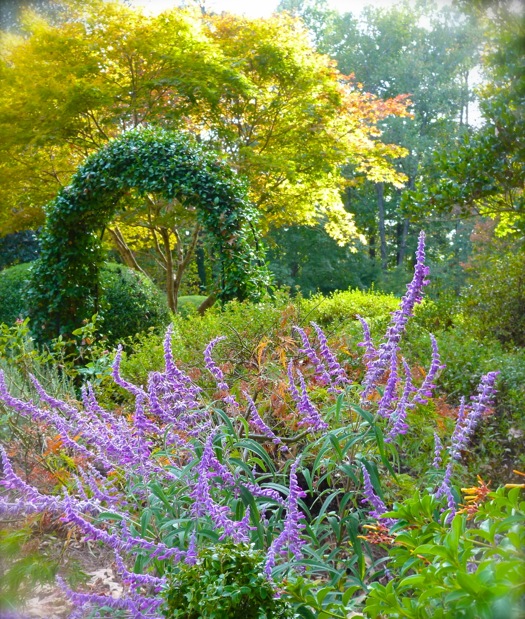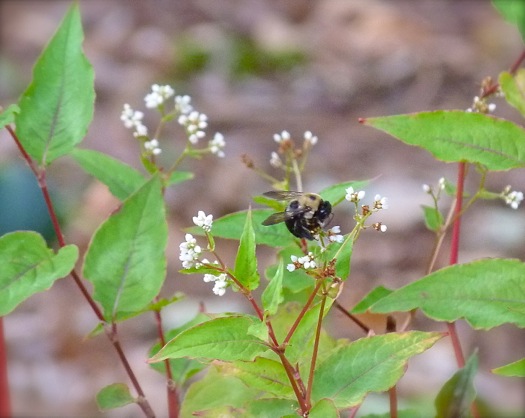Bee Friendly
 Sunday, October 16, 2016 at 4:40PM
Sunday, October 16, 2016 at 4:40PM I have been seeing a variety of bees in the garden lately, including honey bees, carpenter bees and others. Carpenter bees are especially attracted to several fall-flowering plants next to our patio. Every day I see them buzzing around the Mexican Sage (Salvia leucantha), Red Dragon Persicaria, and Caryopteris 'Jason'. Mexican Sage
Mexican Sage  Mexican sage attracts hummingbirds, bees and butterflies. It blooms summer through fall and is hardy to about 15 degrees F.
Mexican sage attracts hummingbirds, bees and butterflies. It blooms summer through fall and is hardy to about 15 degrees F.
 Here is a view of the front garden, looking over the Mexican sage by the patio. The Japanese maple behind the arch is the one attacked by Ambrosia Beetles. I have treated it and removed much of the affected areas. I will wait till spring to see if it survives. Despite the extensive surgery, it is still a beautiful tree.
Here is a view of the front garden, looking over the Mexican sage by the patio. The Japanese maple behind the arch is the one attacked by Ambrosia Beetles. I have treated it and removed much of the affected areas. I will wait till spring to see if it survives. Despite the extensive surgery, it is still a beautiful tree.  A close-up of Mexican Sage; it feels like velvet!
A close-up of Mexican Sage; it feels like velvet!
 Here is another view of Mexican Sage.
Here is another view of Mexican Sage.
 The Mexican Sage coordinates well with this birdhouse. The orange flowers are Firebush, another great plant that attracts hummingbirds, bees and butterflies.
The Mexican Sage coordinates well with this birdhouse. The orange flowers are Firebush, another great plant that attracts hummingbirds, bees and butterflies.
 The pollinators also love Red Dragon Persicaria.
The pollinators also love Red Dragon Persicaria.


 Fall-blooming Caryopteris is also called Blue Mist Shrub or Bluebeard. Be aware there is a spirea called Blue Mist Shrub, which is a different plant!
Fall-blooming Caryopteris is also called Blue Mist Shrub or Bluebeard. Be aware there is a spirea called Blue Mist Shrub, which is a different plant!
Carpenter bees look much like bumblebees in size and appearance, but the top of their abdomens are hairless and shiny black, while bumblebees are fully clothed with hairs, many of them yellow. 
 Carpenter bees are important pollinators and they don't sting you, but they are noted for drilling holes into wooden structures, which they use for nesting and overwintering. They also use trees or telephone poles.
Carpenter bees are important pollinators and they don't sting you, but they are noted for drilling holes into wooden structures, which they use for nesting and overwintering. They also use trees or telephone poles.
Although we have a healthy carpenter bee population around our home, I have never seen any evidence of damage from them. (We do have problems with woodpeckers, who mistake the stucco on the front of our house for dead trees!) Carpenter bees prefer unpainted or old, weathered wood, so the best way to prevent damage to your home is to paint or varnish any wooden structures. Simply staining the wood does not usually work. There also are both chemical and organic products available to get rid of carpenter bees.
Before you decide to kill them, remember that, unlike honey bees, carpenter bees are native to America and they pollinate many types of blooms. A lot of bee species are on the decline due to disease and insecticide use. Without our pollinators, we won't have beautiful gardens or food!
